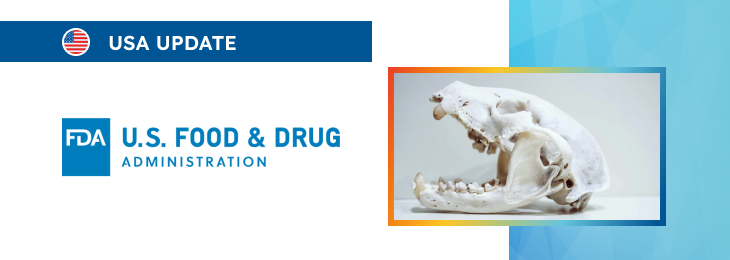The new article provides additional recommendations to be taken into consideration when preparing the submission, in particular with respect to study design and execution.

Table of content
The Food and Drug Administration (FDA or the Agency), the US regulating authority in the sphere of healthcare products, has published a draft guidance dedicated to animal studies for dental bone grafting material devices in the context of premarket notification (510(k)) submissions.
The document provides an overview of the applicable regulatory requirements, as well as additional clarifications and recommendations to be taken into consideration by medical device manufacturers and other parties involved in order to ensure compliance thereto.
At the same time, it is important to mention that provisions of the guidance are non-binding in their legal nature, nor are they intended to introduce new rules or impose new obligations.
Moreover, the authority explicitly states that an alternative approach could be applied, provided such an approach is in line with the relevant legislation and has been agreed with the authority in advance.
Overview of 510(k) Submission Recommendations
The present comprehensive summary describes in detail the recommendations provided by the authority regarding the inclusion of animal study data in 510(k) submissions for dental bone grafting material devices.
These guidelines are intended to provide equivalent or superior public health protection compared to prior directives, emphasizing the importance of using relevant animal models, appropriate study designs, and precise data reporting to demonstrate the safety and effectiveness of these devices.

Importance of Animal Studies
First of all, the authority emphasizes the importance of animal studies. As explained by the FDA, animal studies are critical for evaluating aspects of dental bone grafting materials that cannot be fully assessed through bench testing or clinical studies alone. These studies should be carefully designed to reflect the device’s mechanism of action and address identified health risks.
The FDA encourages adherence to the principles of the “3Rs” – replace, reduce, and refine animal use, suggesting consultation through the Q-Submission Program for potential non-animal testing alternatives.
Justification for Animal Model Selection
According to the guidance, for dental bone grafting materials, the FDA recommends using skeletally mature canine or porcine models due to their anatomical and physiological similarities to human dental structures.
These models provide a more accurate representation of human oral conditions compared to rodent models, which are less suitable due to their continuous bone growth and smaller size, which limits the feasibility of placing adequate graft material.
Study Design and Execution
The document further describes in detail the aspects related to study design, and also the actual execution.
- Animal Model and Study Sites. The chosen animal model should align with the device’s intended clinical use, involving anatomical sites that mirror the intended location of device application in humans. This approach ensures that the study conditions replicate the oral environment’s unique challenges, including saliva flow, masticatory forces, and microbial presence, which are not comparable to other skeletal regions like cranial or orthopedic sites.
- Control and Test Articles. Control selections should include a primary predicate device or a reference device that closely resembles the test device in terms of composition and intended use. Including an empty defect as a negative control is also vitally important to differentiate the effects of the test device from natural healing processes.
- Sample Size and Grouping. Each study should have sufficient sample sizes to generate reliable data, with a minimum of three animals per treatment group per evaluation time point to account for variability and potential loss of animals. The study should use the device in its final form, and the setup should include multiple control and test groups to assess comparative effectiveness and safety.
- Evaluation Time Points and Study Duration. The study should span multiple time points to monitor different stages of bone healing and device resorption, which varies among different materials. The FDA recommends specific time points based on the expected behavior of the material—earlier time points for fast-resorbing materials and later for slow-resorbing ones.
Conclusion
In summary, the present FDA guidance describes in detail the key points to be considered in the context of animal study design for specific categories of healthcare products covered by the scope of the guidance in order to ensure the accuracy and reliability of the results. The document pays special attention to such aspects as the approach to be applied when determining the sample size or time points evaluation.
How Can RegDesk Help?
RegDesk is a holistic Regulatory Information Management System that provides medical device and pharma companies with regulatory intelligence for over 120 markets worldwide. It can help you prepare and publish global applications, manage standards, run change assessments, and obtain real-time alerts on regulatory changes through a centralized platform. Our clients also have access to our network of over 4000 compliance experts worldwide to obtain verification on critical questions. Global expansion has never been this simple.

